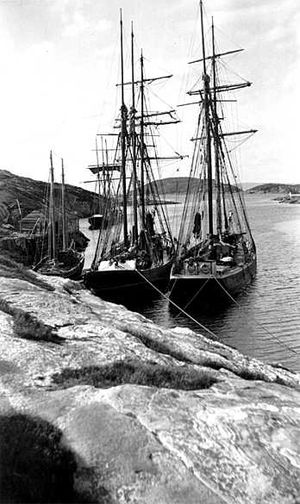Sailing ship
| |
This article needs additional citations for verification. Please help improve this article by adding reliable references. Unsourced material may be challenged and removed. (September 2008) |
- For the song of the same name by After the Fire, see here.
Sailing ship is now used to refer to any large wind-powered vessel. In technical terms, a ship was a sailing vessel with a specific rig of at least three masts, square rigged on all of them, making the sailing adjective redundant. In popular usage "ship" became associated with all large sailing vessels and when steam power came along the adjective became necessary. Large sailing vessels which are not ship rigged may be more appropriately called boats.
Specifications
There are many different types of sailing ship, but they all have certain basic things in common. Every sailing ship has a hull, rigging and at least one mast to hold up the sails that use the wind to power the ship. The crew who sail a ship are called sailors or hands. They take turns to take the watch, the active managers of the ship and her performance for a period. Watches are traditionally four hours long. Some sailing ships use traditional ship's bells to tell the time and regulate the watch system, with the bell being rung once for every half hour into the watch and rung eight times at watch end (a four-hour watch).
Ocean journeys by sailing ship can take many months, and a common hazard is becoming becalmed because of lack of wind, or being blown off course by severe storms or winds that do not allow progress in the desired direction. A severe storm could lead to shipwreck, and the loss of all hands.
Sailing ships can only carry a certain quantity of supplies in their hold, so they have to plan long voyages carefully to include many stops to take on provisions and, in the days before watermakers, fresh water.
Types of sailing ships
There are many types of sailing ships, mostly distinguished by their rigging, hull, keel, or number and configuration of masts. There are also many types of smaller sailboats not listed here.[1] The following is a list of vessel types, many of which have changed in meaning over time:
|
|
See also
| Search Wiktionary | Look up sailing ship in Wiktionary, the free dictionary. |
References
- ↑ The International Sailing Federation's list of sailing classes and equipment
| |||||
zh-min-nan:Phâng-chûn bs:Jedrenjak bg:Ветроходен кораб ca:Veler cs:Plachetnice cy:Llong hwylio da:Sejlskib de:Segelschiff et:Purjekas el:Ιστιοφόρο es:Embarcación a vela eo:Velŝipo eu:Belaontzi fr:Voilier gl:Veleiro hr:Jedrenjak id:Kapal layar is:Seglskúta it:Veliero la:Navis velifera lv:Burinieks lb:Seegelschëff nl:Zeilschip ja:帆船 no:Seilskip nn:Seglskip pl:Żaglowiec pt:Veleiro ro:Velier ru:Парусное судно simple:Sailing ship sk:Plachetnica sr:Једрењак sh:Jedrenjak fi:Purjealus sv:Segelfartyg tr:Yelkenli vi:Thuyền buồm yi:זעגלשיף zh:帆船

